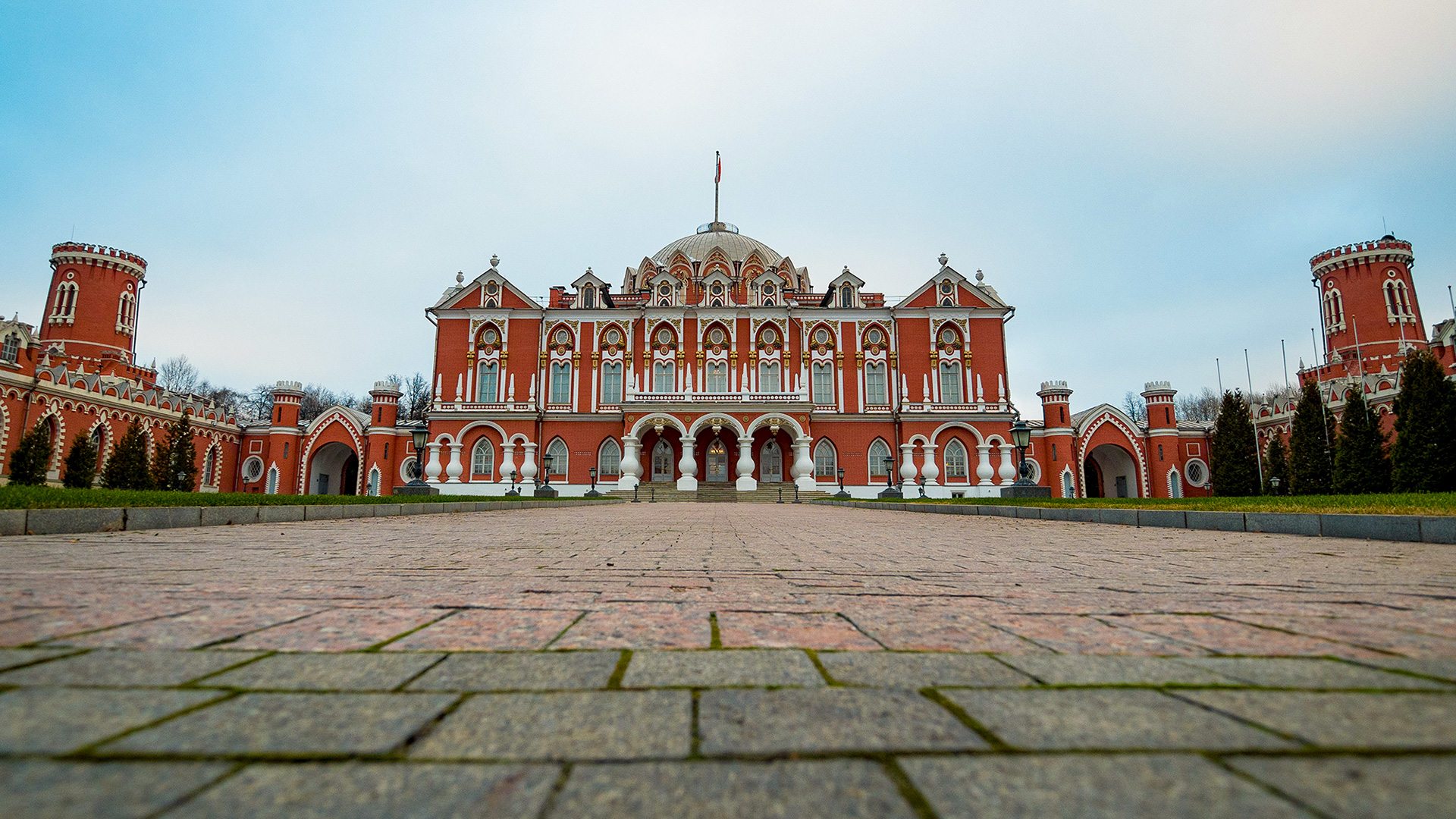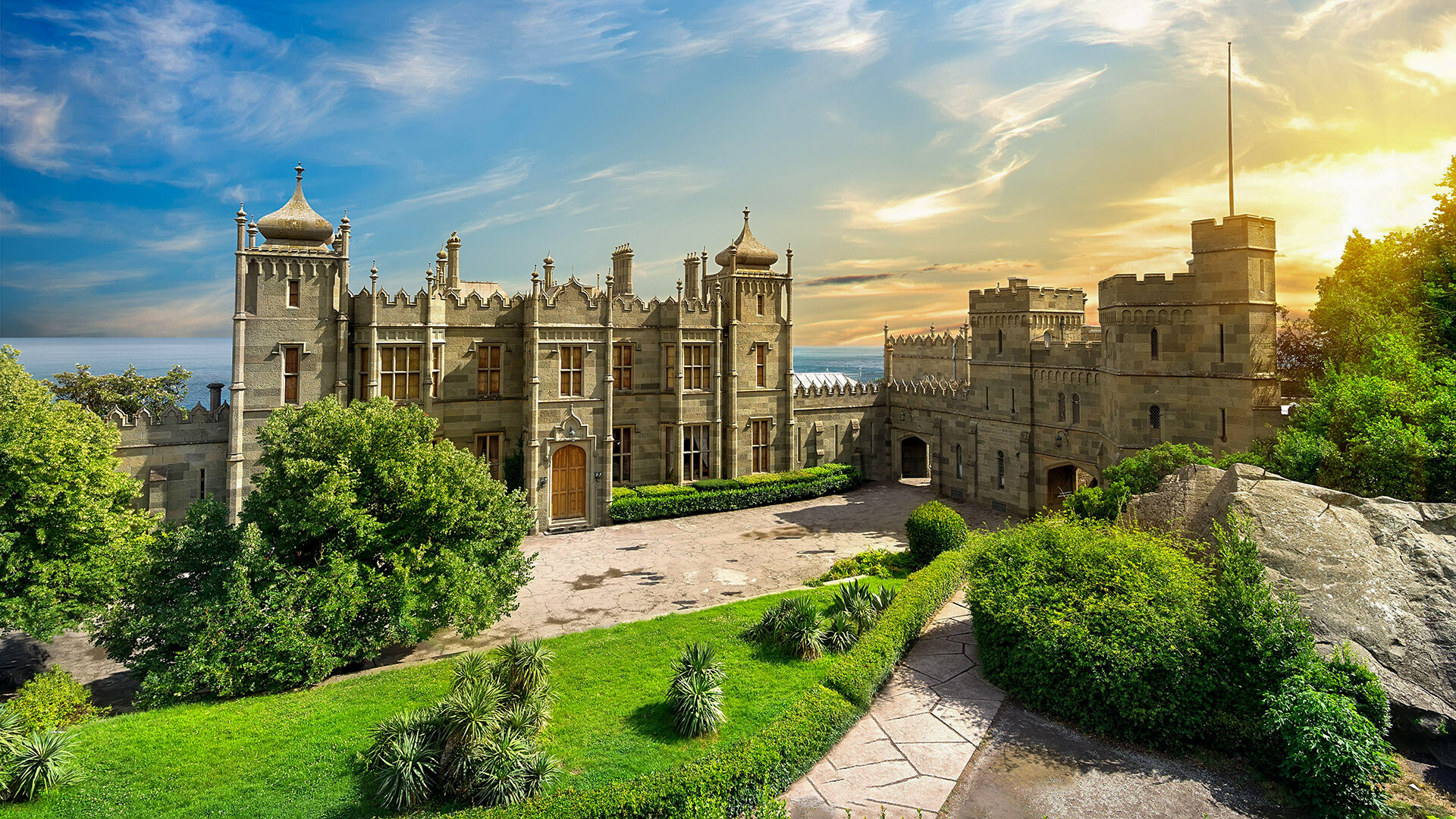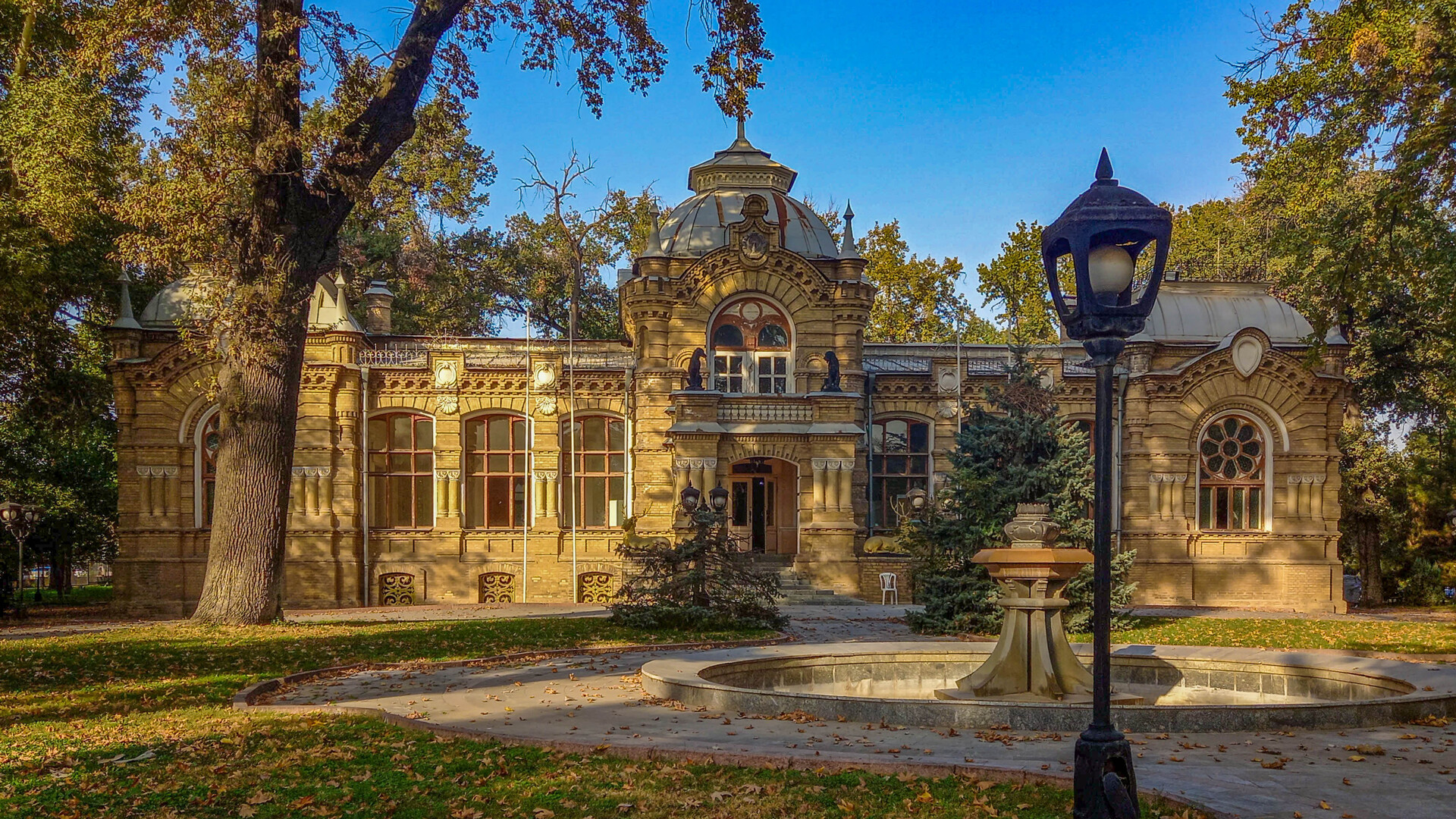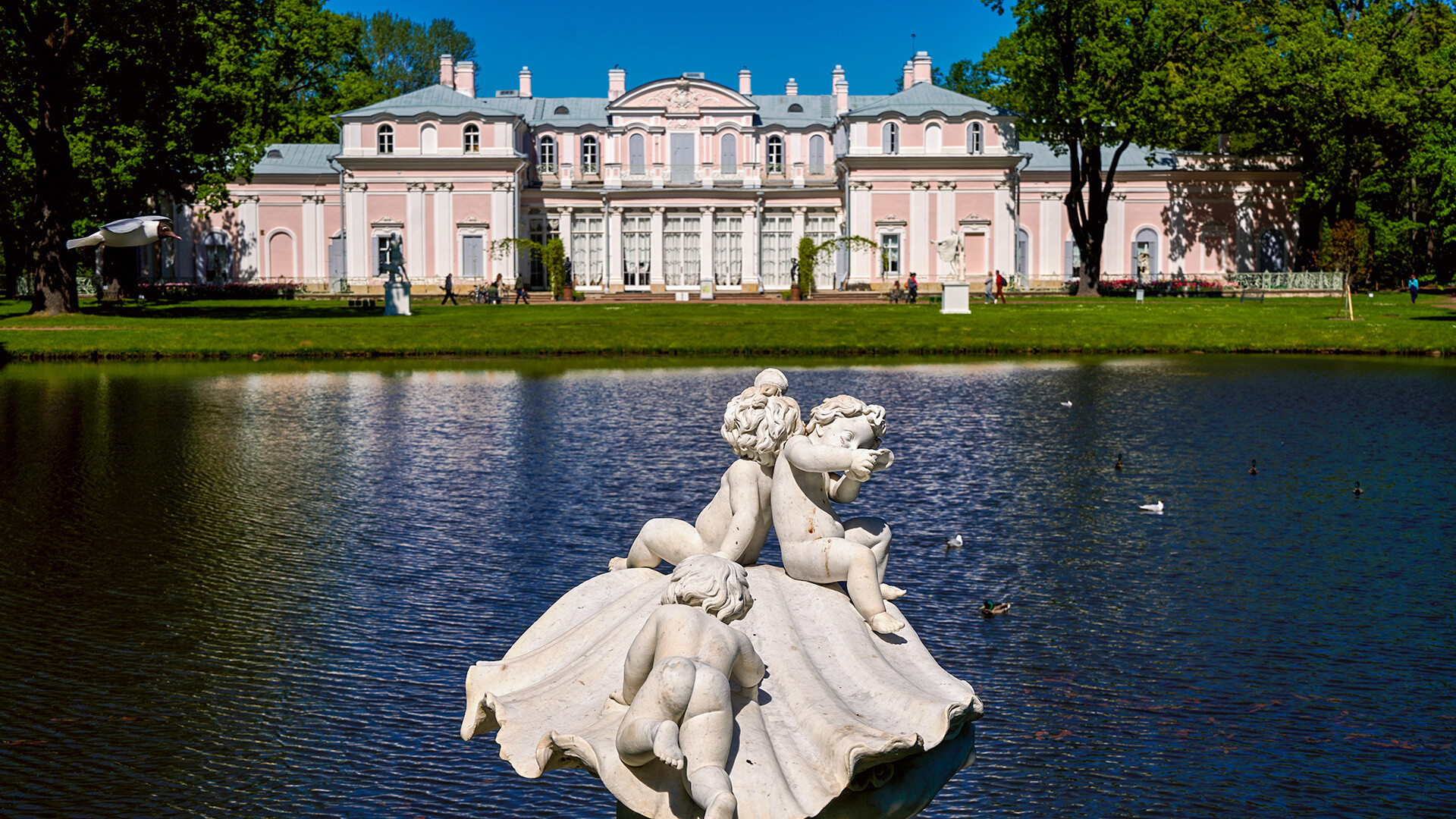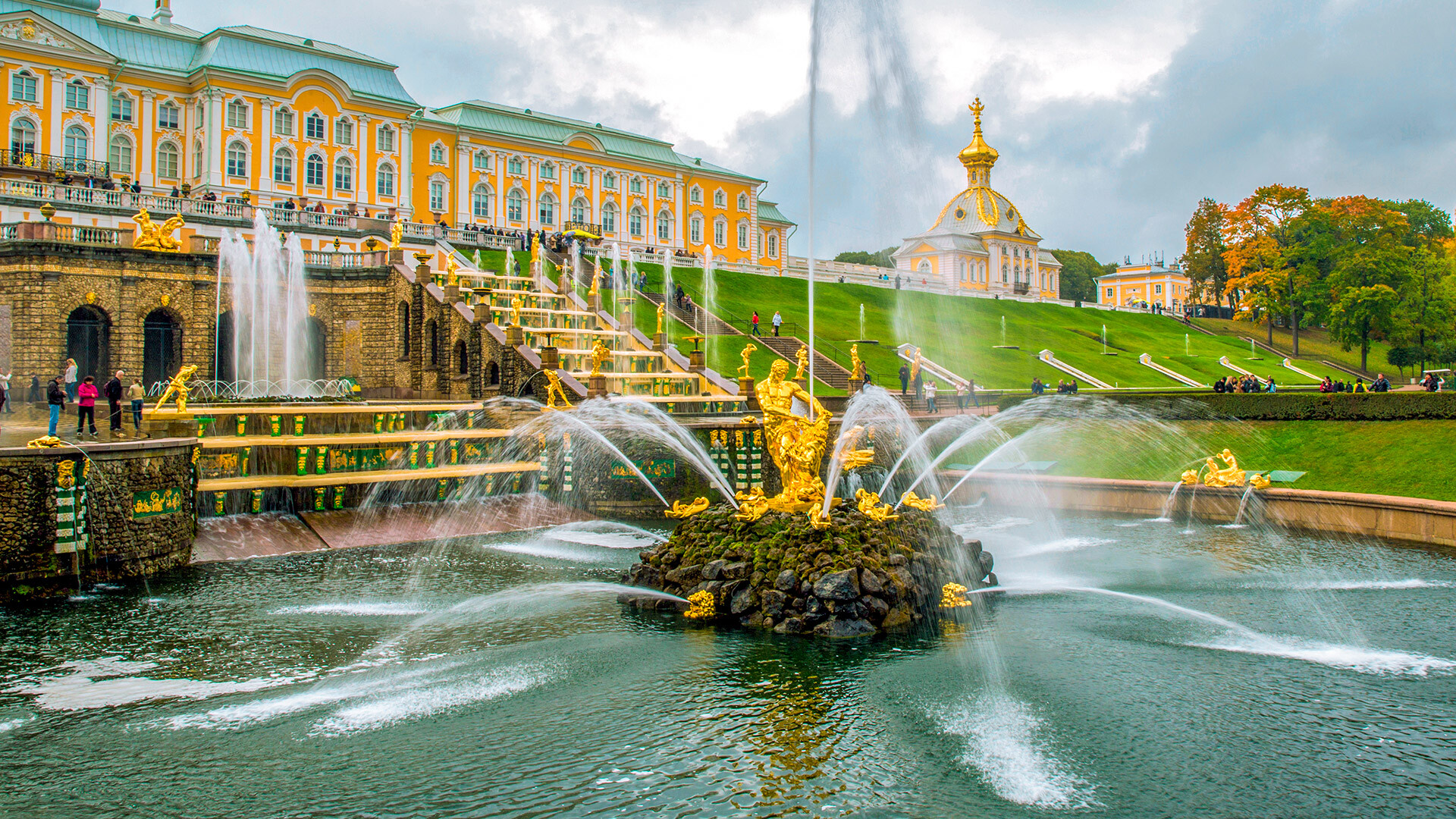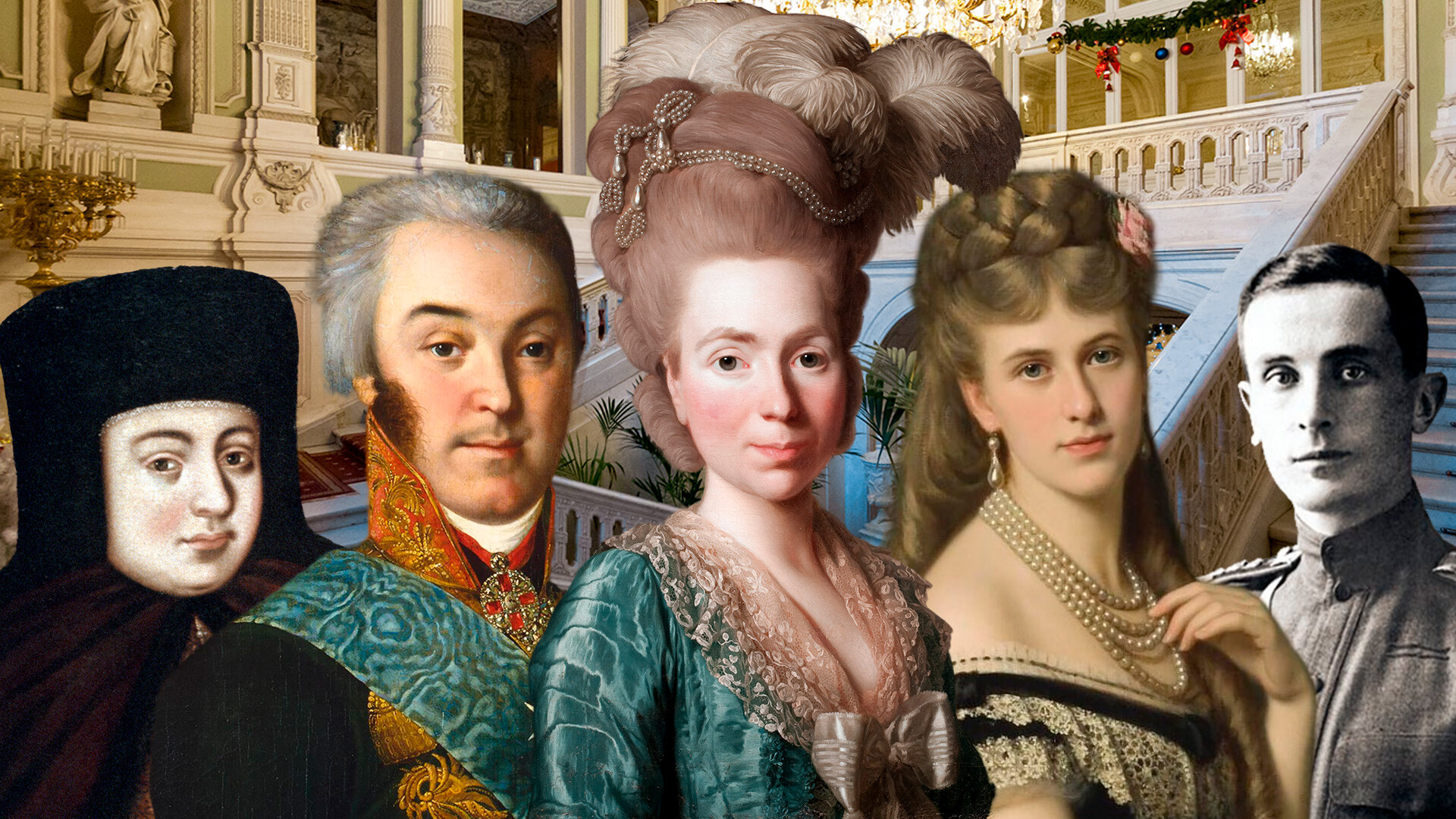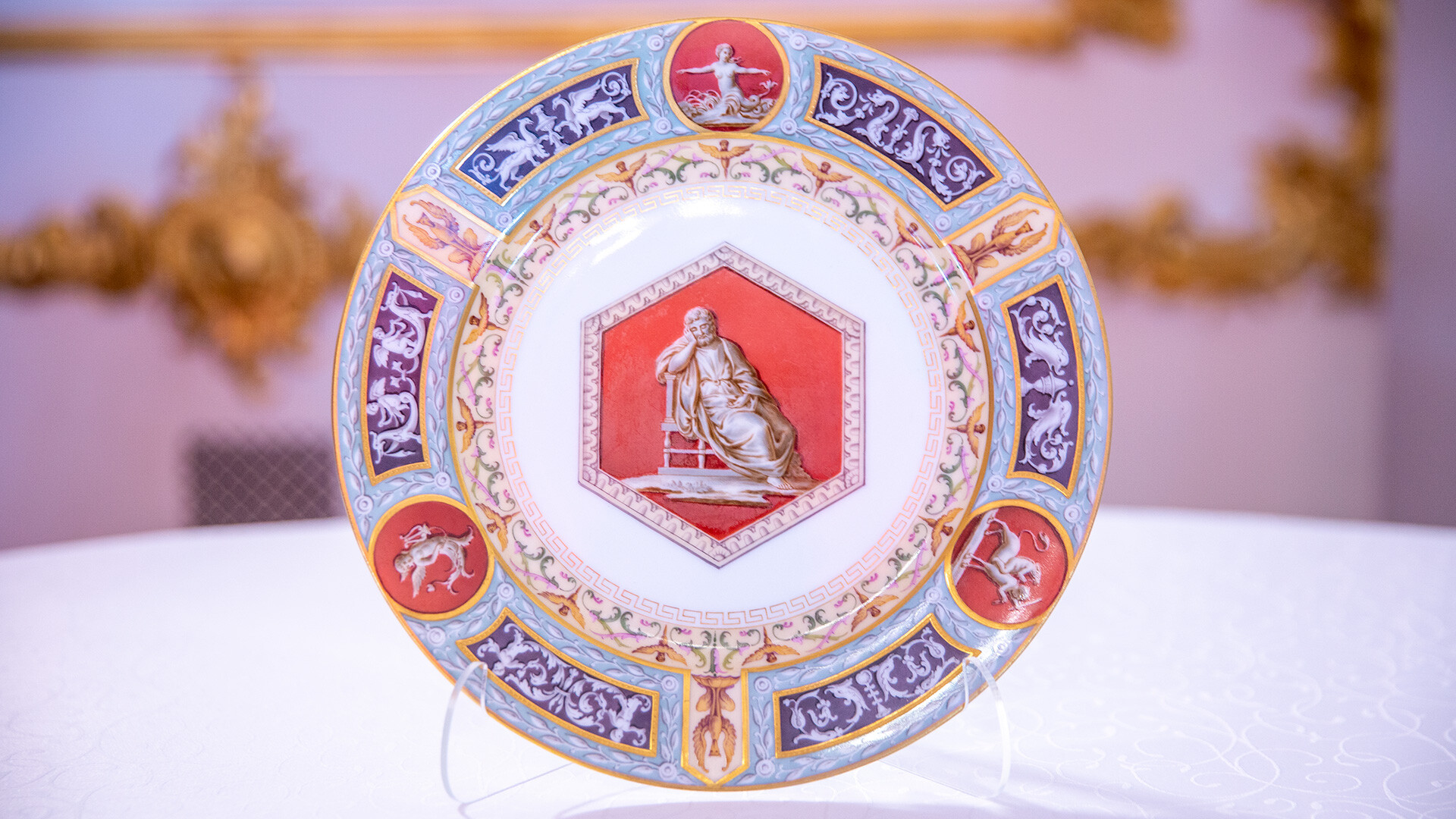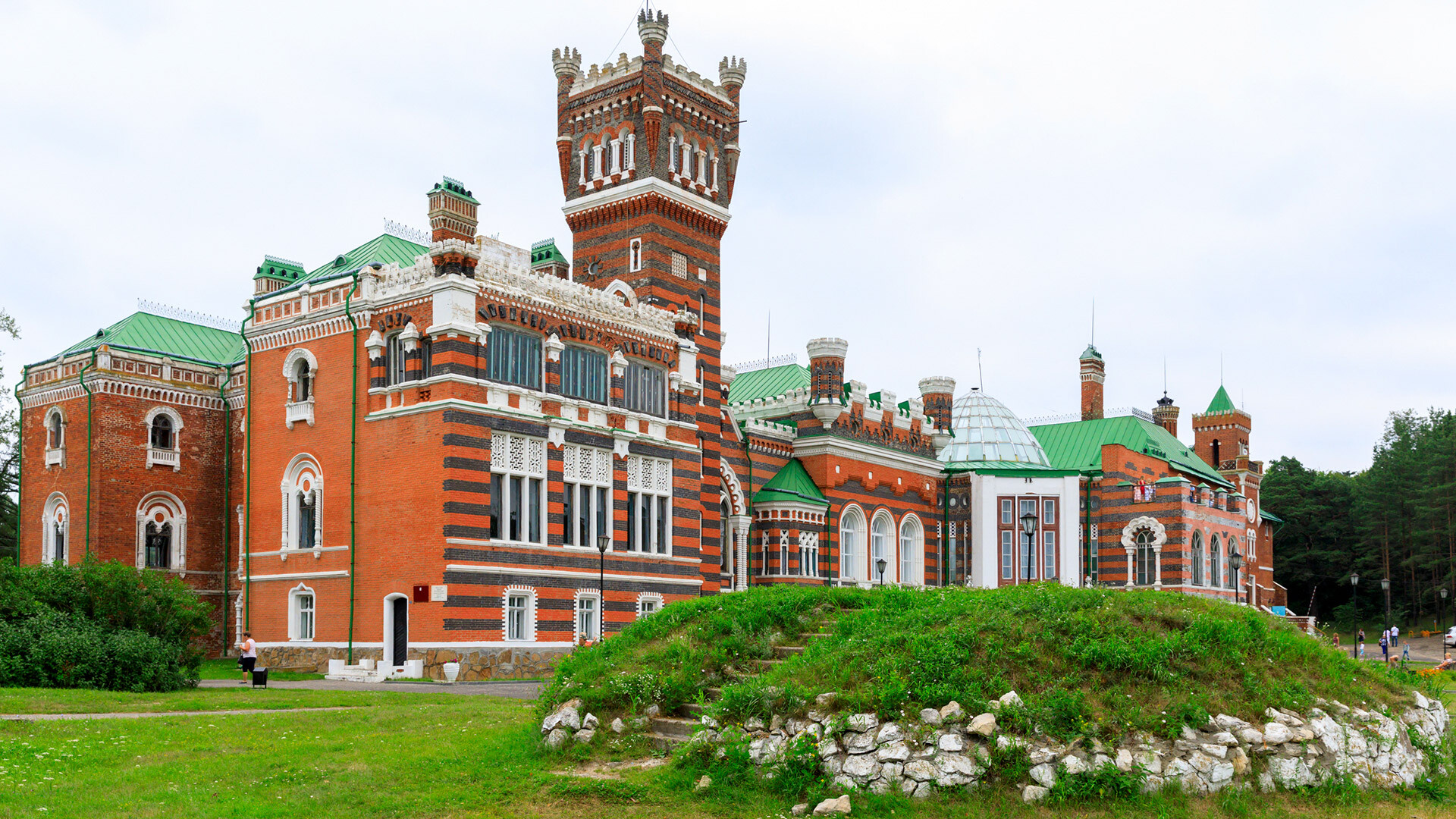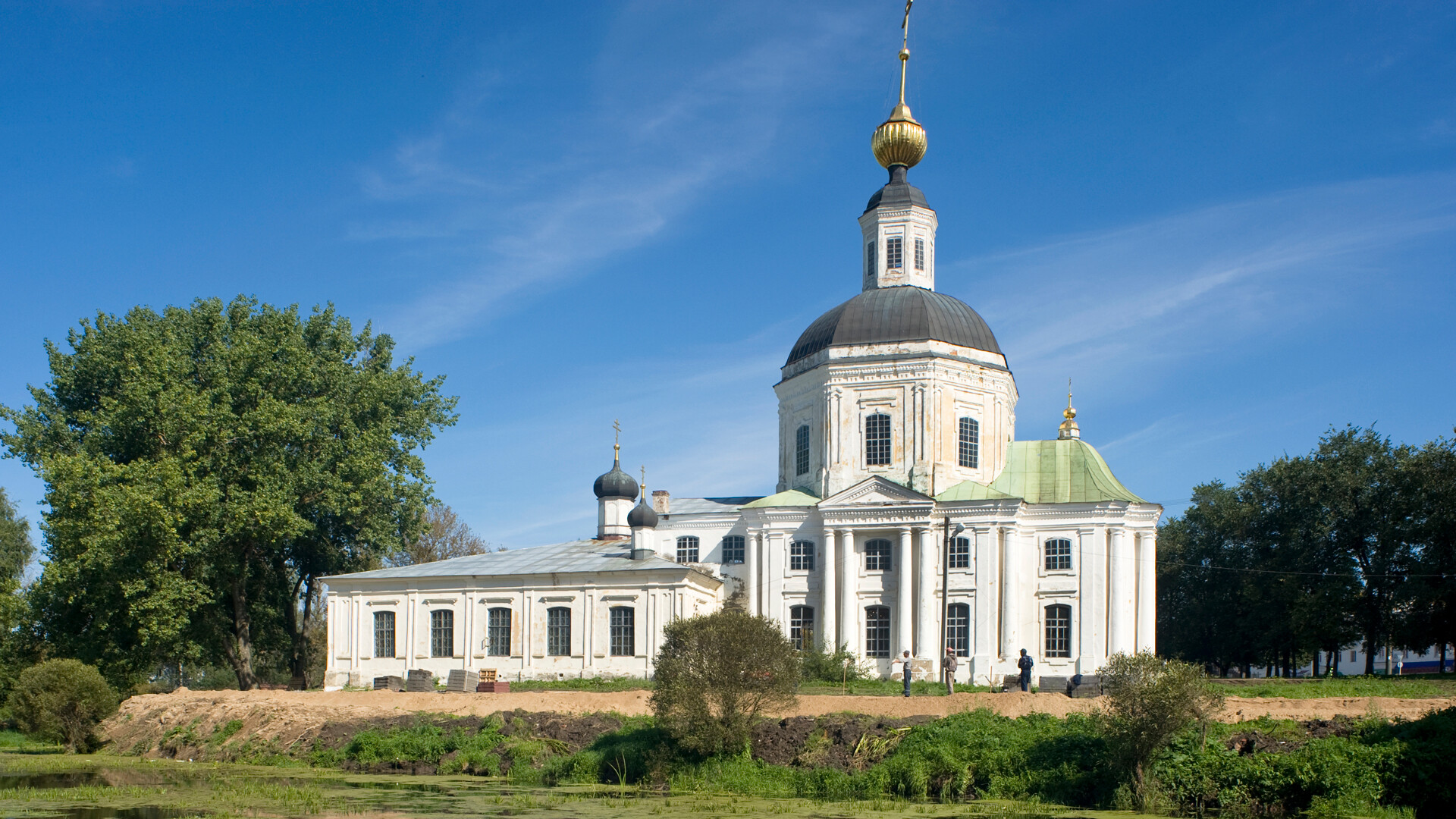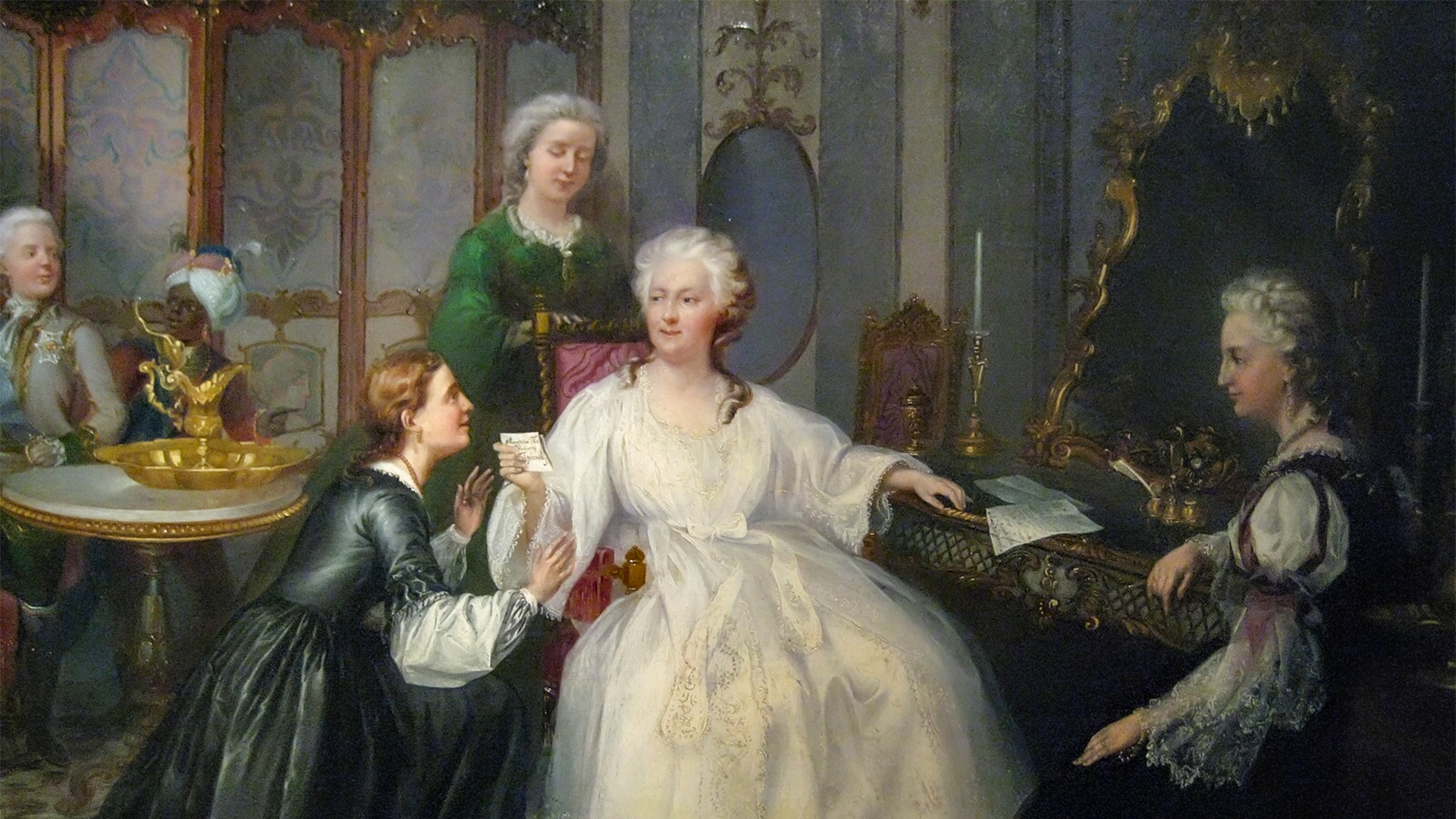
The Sheremetev Palace at Kuskovo: Masterpiece built of wood
 Kuskovo Estate. Sheremetev Palace, view across Large Palace Pond. December 9, 1983
Kuskovo Estate. Sheremetev Palace, view across Large Palace Pond. December 9, 1983
Two hundred and fifty years ago, one of the great architectural monuments from the reign of Catherine the Great was completed on the Sheremetev Estate of Kuskovo. Remarkably, this exquisite jewel is a log structure and it has somehow survived, despite the turbulence of Moscow’s history. Located to the north of the historic center of Moscow, the village of Kuskovo was acquired in 1715 by Boris Sheremetyev – a close associate of Peter I (the Great) and commanding general at the battle of Poltava – who built there a wooden summer residence of modest scale.
 Sheremetev Palace, main facade with Sheremetev coat of arms. The stairs are flanked by a carriage ramp. October 21, 1992
Sheremetev Palace, main facade with Sheremetev coat of arms. The stairs are flanked by a carriage ramp. October 21, 1992
Kuskovo's accession to magnificence began soon after the marriage of his son Peter Borisovich Sheremetyev to Varvara Cherkasskaya in 1743. Not only did the union produce one of the greatest private fortunes in Russia, but the dowry also included serf architects and painters, who were to play the major role in implementing Sheremetyev's expansive plans for the estate. The enhancement of the estate grounds, located next to the Cherkassky estate of Veshnyaki, was no doubt further stimulated by the proximity of Rastrelli's palace for Empress Elizabeth at Perovo – in the same area to the northeast of Moscow.
 Sheremetev Palace, main facade, right side decorated with martial insignia. December 9, 1983
Sheremetev Palace, main facade, right side decorated with martial insignia. December 9, 1983
A summer residence
In 1765, Karl Blank assumed the duties of architect at Kuskovo, where he remained until 1780.3 The main enterprise at Kuskovo during the late 18th century was the creation of an imposing Sheremetyev summer residence. Modifications to the original structure had begun by the 1750s and, in 1755, a large pond was excavated in front of the house. Yet, the grand design of the mansion took shape only in the late 1760s, under the supervision of Blank.
 Kuskovo Estate. From left: Church of the Merciful Savior, bell tower, side facade of palace, kitchen quarters. June 30, 1994
Kuskovo Estate. From left: Church of the Merciful Savior, bell tower, side facade of palace, kitchen quarters. June 30, 1994
The final plan of the main facade and much of the interior followed designs commissioned from the French architect Charles de Wailly, who had worked for Catherine the Great. The structure rested on a limestone and brick foundation, but the structural, load-bearing walls consisted of horizontal courses of pine logs. Although the texture of the plank facing is clearly visible on close inspection, the articulation of the facade conveyed the impression of masonry, with balusters beneath the windows and simply etched panels above.
Framed by flanking projections with a curved pediment over ionic columns and classical motifs carved in wood, the main portico is reached by curving ramps and culminates in a pediment with an elaborately carved Sheremetyev coat of arms.
The interior
 Sheremetev Palace interior. Vestibule with faux marble walls & papier mache vases. March 8, 1972
Sheremetev Palace interior. Vestibule with faux marble walls & papier mache vases. March 8, 1972
The interior is defined by two parallel enfilades – one overlooking the pond (containing the "state" or formal rooms) and the other facing the formal park, with the living rooms on a more intimate scale. Despite its lavish décor, Kuskovo was not intended as a "major" palace, which would have required masonry construction. Much of the interior decoration was derived either from existing Sheremetev palaces in St. Petersburg or from standard patterns, as in the design of the parquet floors (another example of the skills of Russian master carpenters).
 Palace interior. Tapestry drawing room. October 21, 1992
Palace interior. Tapestry drawing room. October 21, 1992
The molding is of papier-mache or plaster, while the larger, architectural details are of faux marble. Despite this illusionistic use of material (suited to the theatrical nature of the house, with the rooms like stage sets, distinct in character and decor), the design and its implementation represent the most accomplished example of French-inspired neoclassical decor in Moscow.
The main entry & rooms
 Palace interior. Crimson drawing room. October 21, 1992
Palace interior. Crimson drawing room. October 21, 1992
The main entry space – the vestibule – was decorated with vases of alabaster, grisaille murals of scenes from classical mythology, scagliola pilasters and capitals of papier-mache and plaster. It opens on either side to a view of the main enfilade of drawing rooms (including the Tapestry Room, with its Chippendale chairs, Flemish tapestries and busts of Peter and Vavara Sheremetyev by Fedot Shubin), which concludes with a blaze of color in the mauve drawing room of the southwest corner.
The color themes of each room – stated primarily by fabrics such as silk damask, satin, and brocatelle – are coordinated not only in relation to the adjoining rooms, but also in regard to the exterior setting and the quality of the natural light through the large windows. The perpendicular turn at the mauve drawing room leads to the State Bedroom, a replica of the same room in the Sheremetyev palace on the Fontanka in St. Petersburg.
Adjoining the State Bedroom is the suite used by the family and connected to the enfilade on the park facade. This suite contains such Russian elements as the ceramic stove with decorative motifs that combine the traditional and the neoclassical.
The ballroom
 Palace interior. Hall of Mirrors (Ballroom) with painted ceiling "Apotheosis of Sheremetev". October 21, 1992
Palace interior. Hall of Mirrors (Ballroom) with painted ceiling "Apotheosis of Sheremetev". October 21, 1992
The references to heroic classicism culminate in the Ballroom, or Mirror Gallery, located at the center of the park enfilade and named for the mirrored inset French windows of the interior wall that reflect the light admitted by their counterparts overlooking the formal park.
 Palace interior. Hall of Mirrors, fireplace & mirror flanked by torcheres & relief panels portraying Gaius Mucius Scaevola. June 5, 1992
Palace interior. Hall of Mirrors, fireplace & mirror flanked by torcheres & relief panels portraying Gaius Mucius Scaevola. June 5, 1992
Mirrors are frequently used in the major rooms at Kuskovo to enlarge the impression of space and to enhance the luster provided by natural light, torchères, and gilded candelabras – a technique that had been explored by Rastrelli and his predecessors in the design of the imperial palaces of St. Petersburg.
 Palace interior. Dining Room with niche containing a bust of Alexander the Great. October 21, 1992
Palace interior. Dining Room with niche containing a bust of Alexander the Great. October 21, 1992
The decoration of the Ballroom displays the iconography of estate culture, particularly in the ceiling painting, executed by Lagrenée and renovated in the 1880s, represents the apotheosis of Petr Sheremetyev surrounded by various muses. The borders of the ceiling are decorated with paintings of his various orders, including the crosses of St. Andrew and St. Anne.
 Palace interior. Dining Room with portraits by Pavel Argunov of Boris Sheremetev and Anna Sheremeteva. October 21, 1992
Palace interior. Dining Room with portraits by Pavel Argunov of Boris Sheremetev and Anna Sheremeteva. October 21, 1992
The heroic values proclaimed by classical iconography are further evident in a series of gilded relief panels – designed by Johann Just for the ends of the ballroom – that depict the exploits of Gaius Mucius Scaevola, the mythic Roman hero of the sixth century B.C. who, having failed to assassinate the Etruscan king Porsenna, held his right hand to the fire as a sign of indifference to physical pain.
 Palace interior. State Bedroom. October 21, 1992
Palace interior. State Bedroom. October 21, 1992
The Mucius Scaevola legend acquired great resonance in Russia at the time of the Napoleonic invasion when it can be said to have penetrated the popular consciousness as a symbol of self-sacrifice and patriotic devotion. For Peter Sheremetyev and his contemporaries, the panels would have served as further expression of the standards of antiquity upheld by the elite of the Russian nobility.
The remaining rooms
 Palace interior. Study with trompe l'oeil paintings. October 21, 1992
Palace interior. Study with trompe l'oeil paintings. October 21, 1992
Although the ballroom extends to the full height of the interior, the other rooms along the park enfilade comprise living suites and have lower ceilings than the state rooms. The additional space above forms an entresol composed of servants' rooms with low ceilings (slightly above human height) illuminated by a second level of small windows extending the length of the park facade.
 Palace interior. Music Room, ceramic stove. October 21, 1992
Palace interior. Music Room, ceramic stove. October 21, 1992
The skillful distribution of space within the floor plan and the means of circulation between the enfilades creates an unusual variety of perspectives as one moves through the house – and out to the steps leading to the parterre of the formal garden. Within the parterre are two monuments to Catherine the Great, including a column with an allegorical statue of Minerva.
 Palace interior. Bedroom of the young Count Sheremetev. October 21, 1992
Palace interior. Bedroom of the young Count Sheremetev. October 21, 1992
The empress visited Kuskovo in 1783, the year of Peter Sheremetyev's election to the honorific post as head of the Moscow nobility. By that time, the park extending from the palace had been enhanced by the construction of many pavilions for the delight of guests to the estate.
A wooden miracle
 Palace, park facade. October 21, 1992
Palace, park facade. October 21, 1992
In the 1790s, however, Sheremetyev's son Nicholas tired of the scale of entertainment and perhaps also of the style of Kuskovo. He had spent much of his youth in Holland and France, was familiar with recent developments in Western art, and – typically for third generation fortunes – preferred to devote himself to the pursuit of the arts, with a special interest in theater.
 Palace park. Grotto Pavilion. December 9, 1983
Palace park. Grotto Pavilion. December 9, 1983
Having formed at Kuskovo the leading serf theatrical troupe in Russia, Nicholas Sheremetyev in 1792 undertook the construction of a palace-theater at his neighboring estate of Ostankino, which will be the subject of another episode in Moscow’s rich architectural history.
 Grotto interior. Ceiling composed of thousands of shells. October 21, 1992
Grotto interior. Ceiling composed of thousands of shells. October 21, 1992
As for Kuskovo, this masterpiece survived damage during the French occupation of Moscow in the autumn of 1812, was preserved throughout the 19th century, and became a major cultural site during the Soviet period. The miraculous life of this wooden marvel continues undiminished in yet another century.
 Palace park. Hermitage Pavilion. October 21, 1992
Palace park. Hermitage Pavilion. October 21, 1992


